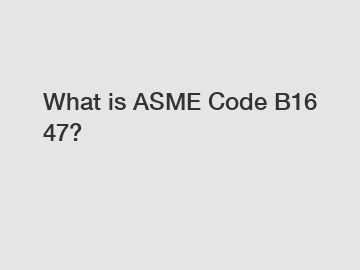What is ASME Code B16 47?
Welcome to our comprehensive guide on ASME Code B16 47. As industries continue to evolve, standards and codes play a vital role in ensuring safety, efficiency, and compatibility. In this blog, we will delve into the depths of ASME Code B16 47, shedding light on its significance, its key features, and the industries it impacts. So, let's get started!
Understanding ASME Code B16 47:
ASME Code B16 47, also known as the ASME B16.47 Series, is a collection of standards published by the American Society of Mechanical Engineers (ASME). These standards deal with the dimensions and pressure ratings of large diameter steel flanges (NPS 26 through NPS 60). Essentially, it provides guidelines for the design, manufacture, and installation of these critical components.

The Significance of ASME Code B16 47:
ASME Code B16 47 is highly significant in several industries, such as oil and gas, petrochemical, chemical, power generation, and shipbuilding. Large diameter flanges are crucial for connecting pipes, valves, and other equipment, ensuring the integrity of fluid and gas flow systems. Therefore, adherence to ASME Code B16 47 guarantees compatibility, proper functioning, and, most importantly, the safety of such systems.
Key Features and Specifications:
1. Dimensions: ASME Code B16 47 specifies the dimensions of these large diameter flanges, including bolt hole sizes, flange outer diameter, facing methods, and flange thickness. These dimensions enable proper alignment and connection within the system.
2. Pressure Ratings: The Code provides guidelines for pressure ratings, which indicate the maximum pressure a flange can withstand. It ensures that the selected flange can handle the required pressure loads, maintaining system efficiency and preventing potential failures.
3. Material Specifications: ASME Code B16 47 addresses the material requirements for flanges, ensuring they have the necessary strength, corrosion resistance, and reliability. It also provides guidelines for heat treatment, forging, and manufacturing processes.
4. Flange Types: The Code covers two main types of large diameter flanges - series A and series B - that differ in their face-to-face dimensions. Understanding these distinctions is crucial for compatibility during installation.
Applications in Various Industries:
1. Oil and Gas: From upstream exploration to downstream refining, ASME Code B16 47 ensures the interconnectivity and safety of oil and gas flow systems, supporting efficient operations and minimizing the risk of leaks or catastrophic failures.
2. Petrochemical: ASME Code B16 47 is vital in the petrochemical industry, where large quantities of chemicals and fluids are processed. The Code's standards guarantee that flanges in these systems can handle the demanding operating conditions.
3. Chemical: When handling hazardous and corrosive chemicals, maintaining the integrity of fluid handling systems is critical. ASME Code B16 47 ensures the proper selection and installation of large diameter flanges, safeguarding personnel, equipment, and the environment.
4. Power Generation: Large-scale power plants rely on ASME Code B16 47 for the safe and efficient transport of steam, water, and gas within the system. Compliance ensures reliability, minimizes leaks, and reduces the risks of energy loss.
5. Shipbuilding: Vessels at sea face harsh environments and extreme conditions. ASME Code B16 47 provides shipbuilders with the necessary guidelines to select and install robust flanges, ensuring leak-free and reliable fluid transport.
Conclusion:
ASME Code B16 47 plays a crucial role in maintaining the integrity, safety, and efficiency of large diameter flanges used in various industries. Its specifications, dimensions, and pressure ratings allow engineers and manufacturers to make informed decisions during the design, manufacturing, and installation processes. By adhering to this code, industries can establish compatibility, minimize risks, and ultimately ensure smooth and reliable operations.
If you are looking for more details, kindly visit wn 3353, insulating joint cathodic protection, pigging receiver.
119
0
0


Comments
All Comments (0)